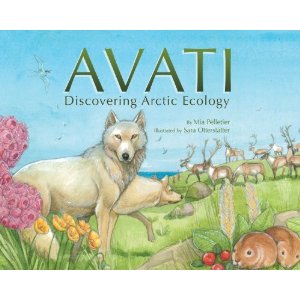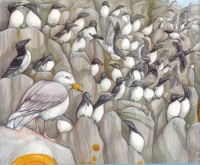| ________________
CM . . .
. Volume XIX Number 41. . . .June 21, 2013 
 |
Avati: Discovering Arctic Ecology.
Mia Pelletier. Illustrated by Sara Otterstätter.
Iqaluit, NU: Inhabit Media, 2013.
45 pp., hardcover, $14.95.
ISBN 978-1-927095-13-3.
Subject Heading:
Ecology-Arctic region-Juvenile literature.
Grades 4-8 / Ages 9-13.
Review by Gillian Green.
**½ /4
|
| |
|

excerpt:
"Kek-kek-kek!" Arctic terns nest on the ground in noisy colonies, plunge-diving for fish and marine invertebrates in the nearby ocean. Fierce defenders of their eggs, terns will aggressively attack any predator that enters the colony. To benefit from this protection, a female red phalarope, in her stunning summer feathers, has laid her speckled eggs close by. She spins in circles on a nearby pond, making a whirlpool that traps aquatic bugs, which she plucks for the water and eats. Enjoying one last meal, she leaves her mate behind to incubate her eggs. His less colourful feathers blend in so perfectly with the tundra that he cannot be seen.
Avati means "environment" in Inuktitut, the language of the Inuit. Initial thoughts of the Arctic environment may include images of a barren, cold and lifeless landscape. This book illustrates that it is actually a dynamic and complex ecosystem which contains many ecological relationships between plants and animals.
 Avati: Discovering Arctic Ecology introduces the reader to the year-round life cycle of the Arctic. With the text beginning in spring and continuing through to winter, the reader learns how each animal, plant and insect plays an important role in the continuation of life. Each two-page spread focuses on one specific time of year, such as high summer or winter nights, providing detailed facts about habitat, nesting, diet and other biological tidbits. The text is long and detailed, covering many species of unfamiliar animal, plant or insect species. The meticulous illustrations by Sara Otterstatter are large, clear and accurate, although at times may be overwhelming as they reflect the text. Mia Pelletier has a strong background in wildlife ecology and lives on Baffin Island where she works with Inuit on co-management of protected areas of Arctic seabirds. It is her interest in the ecosystems on the Arctic tundra that inspired her to write this book. Avati: Discovering Arctic Ecology introduces the reader to the year-round life cycle of the Arctic. With the text beginning in spring and continuing through to winter, the reader learns how each animal, plant and insect plays an important role in the continuation of life. Each two-page spread focuses on one specific time of year, such as high summer or winter nights, providing detailed facts about habitat, nesting, diet and other biological tidbits. The text is long and detailed, covering many species of unfamiliar animal, plant or insect species. The meticulous illustrations by Sara Otterstatter are large, clear and accurate, although at times may be overwhelming as they reflect the text. Mia Pelletier has a strong background in wildlife ecology and lives on Baffin Island where she works with Inuit on co-management of protected areas of Arctic seabirds. It is her interest in the ecosystems on the Arctic tundra that inspired her to write this book.
A glossary at the end of the book defines italicized scientific terms used in the text. However, an index would have been very helpful for a young researcher to access the information in this book easily. Avati: Discovering Arctic Ecology would be a good addition to any school library, but it might be a little cumbersome for a personal library.
Recommended.
Gillian Green is a children’s reference librarian in Woodstock, ON.

To comment
on this title or this review, send mail to cm@umanitoba.ca.
Copyright © the Manitoba Library Association. Reproduction for personal
use is permitted only if this copyright notice is maintained. Any
other reproduction is prohibited without permission.
NEXT REVIEW |
TABLE OF CONTENTS FOR THIS ISSUE
- June 21, 2013.
AUTHORS |
TITLES |
MEDIA REVIEWS |
PROFILES |
BACK ISSUES |
SEARCH |
CMARCHIVE |
HOME |

 Avati: Discovering Arctic Ecology introduces the reader to the year-round life cycle of the Arctic. With the text beginning in spring and continuing through to winter, the reader learns how each animal, plant and insect plays an important role in the continuation of life. Each two-page spread focuses on one specific time of year, such as high summer or winter nights, providing detailed facts about habitat, nesting, diet and other biological tidbits. The text is long and detailed, covering many species of unfamiliar animal, plant or insect species. The meticulous illustrations by Sara Otterstatter are large, clear and accurate, although at times may be overwhelming as they reflect the text. Mia Pelletier has a strong background in wildlife ecology and lives on Baffin Island where she works with Inuit on co-management of protected areas of Arctic seabirds. It is her interest in the ecosystems on the Arctic tundra that inspired her to write this book.
Avati: Discovering Arctic Ecology introduces the reader to the year-round life cycle of the Arctic. With the text beginning in spring and continuing through to winter, the reader learns how each animal, plant and insect plays an important role in the continuation of life. Each two-page spread focuses on one specific time of year, such as high summer or winter nights, providing detailed facts about habitat, nesting, diet and other biological tidbits. The text is long and detailed, covering many species of unfamiliar animal, plant or insect species. The meticulous illustrations by Sara Otterstatter are large, clear and accurate, although at times may be overwhelming as they reflect the text. Mia Pelletier has a strong background in wildlife ecology and lives on Baffin Island where she works with Inuit on co-management of protected areas of Arctic seabirds. It is her interest in the ecosystems on the Arctic tundra that inspired her to write this book.